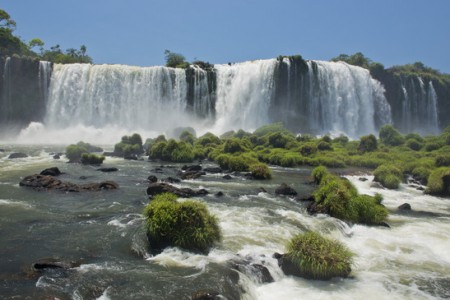Iguazu Falls are located in South America, close to the point where Paraguay, Brazil, and Argentina join borders. The Iguazu River forms a border between Argentina and Brazil. Iguazu Falls was listed in the UNESCO World Natural Heritage Site, the word Iguazu comes from the Native American Guarnai word for ‘great water’, the falls were forms by volcanic activity approximately 100 million years ago.
The first European to see the Iguazu falls was Cabeza de Vaca in 1542. He was on an expedition through the region populated by the Caiagangue and Tupi-Gurani Indians. In search for a river route to Paraguay, the falls presented themselves as a startling obstacle.
The Iguazu River rises near the city of Curitiba. For most of its course, the river flows through Brazil, however, most of the falls are on the Argentine side. Below its confluence with the San Antonio River, the Iguazu River forms the boundary between Argentina and Brazil.
The edge of the basalt cap recedes by 3 mm (0.1 in) per year. The water of the lower Iguazu collects in a canyon that drains into the Paraná River, a short distance downstream from the Itaipu Dam.
On the Brazilian side, there is a walkway along the canyon with an extension to the lower base of Devil’s Throat. Helicopter rides offering aerial views of the falls have been available from Brazil, however, Argentina has prohibited such helicopter tours because of the adverse environmental impact on the flora and fauna of the falls.
From Foz do Iguaçu airport, the park may be reached by taking a taxi or bus to the entrance of the park. There is an entrance fee to the park on both sides. Once inside, free and frequent buses are provided to various points within the park.
The Argentina section is the part containing numerous segmented waterfalls as a result of islands (the largest of which is the San Martin Island, or La Isla San Martín) splitting up the river. Like Niagara and most waterfalls, Iguazu is retreating due to the erosion of the water on the basalt landscape.
The original location of the falls was actually 28km downstream from present day, and these falls will keep on moving farther and farther back as time goes on.

part of the iguazu falls, seen from the brazilian side, one of the world’s seven natural wonders
In the present day, the parks are mostly surrounded by a landscape that has been strongly altered due to heavy logging, both historically and into the present, the intensification and expansion of both industrial and small-scale agriculture, plantation forestry for pulp and paper and rural settlements.
Iguazú National Park has a long conservation history dating back to the early 20th Century and was declared a national park in 1934 illustrating the longstanding recognition of its quality. The integrity of Iguazú National Park must be considered in conjunction with the sister property in neighbouring Brazil.
Jointly, the two properties constitute a valuable remnant of a once much larger forest area and adequately conserve the splendid system of waterfalls. The site is particularly rich in bird speices with almost half of Argentina’s bird species found there. Threatened mammals such as the jaguar, ocelot and tiger-cat number among the carnivores, and the giant anteater and Brazilian otter are also found.